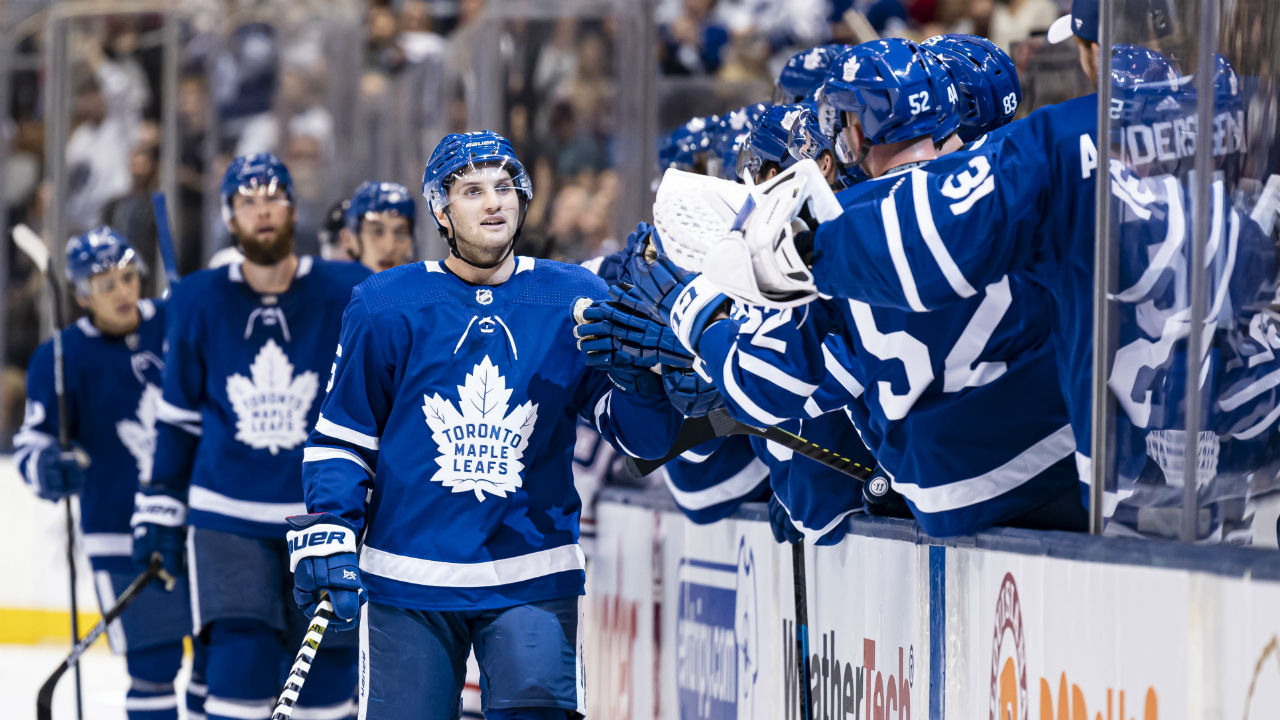gambit definition: “1. a clever action in a game or other situation that is intended to achieve an advantage and usually involves taking a risk.”
When Alexander Kerfoot joined the Toronto Maple Leafs back in July as part of a larger transaction involving Nazem Kadri, I thought the trade was akin to a gambit in chess — a high-reward, high-risk move.
It was driven by the need for the Toronto Maple Leafs to exchange a quality forward piece in exchange for a top-four right-handed defenseman and a replacement third-line center.
A few days before, I had the idea for the trade triggered by the fact that the Leafs had passed on Colin Miller:
I tweeted last night how a RD solution could still happen. Here’s a mockup example: #Leafs trade Kadri and Brown for Tyson Barrie and Alex Kerfoot.
Kerfoot is a 24 yr old RFA C, Barrie has 1 year left at $5.5M. The trade would be contingent on Barrie extending at $7M. pic.twitter.com/O4X667rkPW— Bill Comeau (@Billius27) June 30, 2019
What was just an idea of mine on June 30 became very real on July 1st when the trade was announced. I was clearly wrong on some of the final details, but I was pleased that the Leafs could pull this off (as much as I love Nazem Kadri).
Toronto Maple Leafs acquire Tyson Barrie, Alex Kerfoot in exchange for Nazem Kadri#LeafsForever
More: https://t.co/wTO4wn3RKA
— Maple Leafs Hotstove (@LeafsNews) July 1, 2019
Kyle Dubas talked about what he was looking for just after the trade.
“We were trying to find a trade partner where everyone could come out on the winning end of it, where a team could address their need for a top-end, proven center and we could get a center back — hopefully someone younger who is a little bit cheaper that we could plug into our lineup and replace Naz.”
When the Leafs General Manager flipped the switch on July 1st, he dramatically altered his team’s roster. Few had doubts that Tyson Barrie would play an important role in shoring up the right-side defense, but the real gamble was replacing a piece of the Toronto Maple Leafs core, Nazem Kadri, with a largely unproven center.
The key to replacing Kadri wasn’t necessarily about offense. With two elite centers in Auston Matthews and John Tavares and limited cap space, a third-line center replacement would normally be expected to cost less, provide a solid two-way game, and help drive play for Toronto’s strong winger depth.
Alexander Kerfoot’s 2018-19 Season
Eyeballing a player without numbers can be misleading. Maybe that play was rare for that player or maybe we are zoning in on one thing — like blooper-reel mistakes — or only when he carries the puck? In 15 minutes, maybe we only recall three of ten plays?
Likewise, numbers don’t tell the whole story. How does he produce those numbers? What are his skills? Are they repeatable? Is he a good skater or puck-handler? How does he battle for the puck? How does he exit the zone?
This is why I will include a few clips to help understand how a player is achieving results. But over a season, the only way to get a handle on the level of play is to measure it with numbers and compare him to other forwards.
My focus is on his 5v5 play in what follows. That’s what matters most to the Toronto Maple Leafs.
SKATR
SKATR is a 5v5 player evaluation tool I developed two years ago. The Kerfoot summary for 2018-19 is below. It, along with other research, helped point me to the Kerfoot/Barrie possibility in the first place.
A sidebar on SKATR:
The bars show Kerfoot’s percentile rankings among NHL forwards. Longer bluer bars are “better” and shorter redder bars are “worse”. The percentiles are also labeled on the left side of each bar. More on SKATR and its statistics can be found here.
It’s divided into four main sections, focusing on common box score stats like points, underlying numbers behind the results, play-driving based on two-way shot differentials, and finally the coach’s deployment. Keep in mind that some of these measures overlap, like the breakdown of Relative to Teammates CF% into CF (shots for) and CA (shots against). Also, SKATR bases its percentiles on 5v5 rate statistics, so ‘Goals’ means Goals per 60 minutes, for example.
As a rough guide, if we’re looking for a typical third-line center, we would expect to see a range of bars centred mostly around the 30th-50th percentiles. We need to keep in mind, though, that Kerfoot played a lot of time on the wing last season, so his results were a center/winger mix.

Key Takeaways
1. Kerfoot does not shoot the puck often and his goal scoring is average
Last season, he averaged just 10 shot attempts per 60 minutes, putting him at the 27th percentile among NHL forwards. He was limited to nine goals at 5v5 (45th percentile) and had an average shooting percentage (9.2%, 50th percentile). (He scored a respectable 15 goals overall.)
2. He has good passing skills
He ranks high at both primary assist rate (61st percentile) and estimated shot assist rate (77th percentile). (An estimated shot assist is based on a sample of manually tracked passes that lead directly to shots, whether the shot scored or not.) He recorded 22 assists at 5v5.
There may be untapped potential in Kerfoot’s playmaking, considering his quality of teammates ranked at the 42nd percentile.
Alex Kerfoot ranks at the 96th percentile in frequency of dangerous passes that go across the slot or behind the net and lead directly to shots.
(This is based on 275 minutes of manually tracked data over 2017-2019, courtesy Ryan Stimson, not shown in chart above.)
3. He drives play
When Kerfoot was on the ice at 5v5, Colorado had the advantage in both shot share (CF%) and expected goal share (xGF%). The CF% and xGF% were excellent, ranking at the 72nd and 82nd percentiles.
Sometimes that can be the result of teammates, so let’s try to isolate his contribution. Kerfoot’s relative to teammate results are even more impressive; his relative to teammate expected goal share (xGF%) was +5.3%, which placed him at a lofty 89th percentile. His equivalent relative shot share stood at the 82nd percentile. In other words, he boosted the results of his teammates when it came to tilting the ice for the Avalanche.
4. Kerfoot’s defensive results are promising
Kerfoot had very good shot suppression and expected goal suppression numbers last season. Kerfoot’s relative to teammate shots against (87) and expected goals against (94) percentiles were top tier. This is important for a third-line center and suggests he has some defensive ‘chops’ to his game. (Note: “Relative to teammate” metrics estimate a player’s impact by comparing teammate results with or without him on the ice; the bars and percentiles are always set to show higher rankings as “better”, even if that means fewer shots against in this case.)
Another angle to looks at his defense is via the heat maps produced by Micah Blake McCurdy. Kerfoot’s 5v5 isolated impact in the defensive zone was estimated at -4% over the last two seasons. That -4% means he reduced the threat from the opposition by 4%. The heat map below highlights areas of above-average shot threats in red and areas with fewer shots in blue. Mind you, he was playing as a winger a lot of the time, so how he handles full-time center defensive duties on a different team is still an open question.
5. Alex Kerfoot has a strong transition game
This chart by CJ Turtoro covers manually tracked zone entries and zone exits based on the work of Corey Sznajder.

Kerfoot was very successful at exiting his zone and entering the offensive zone (67th and 82nd percentiles) based on a tracking sample of 600 minutes. Forwards who can transition well across both blue lines are a good fit for a Maple Leafs team that emphasizes quick movement and a high-pace game.
6. Alex Kerfoot is probably a 35-50 point player, but there’s a lot of uncertainty
For those who love point production, it’s too early to really know what Kerfoot’s upside is. After 43 and 42 point seasons with the Avalanche — which included some power-play time — it’s more likely in the 35-50 point range. But you never know how he will develop on a high-pace team and with good third-line wingers. It will also depend on how much power-play time he receives. Last season, he tallied four goals and 12 assists in 161 minutes on the power play.
I was curious and took a peek at how he has done so far in 5v5 points per 60 minutes compared to the last two third-line centers for the Leafs. To make it fair, I looked at their age-equivalent seasons. As you can see, at this stage, it’s really hard to guess what will happen point-wise, but it’s certainly not out of the question that he improves on last season given the Leafs’ high pace game and depth at wing.
2018-19 Video Highlights
Now let’s pull all this together and watch the player to get a sense of how he put up the numbers we were reviewing.
- The first sequence in the video below shows Kerfoot’s fluid skating through the neutral zone, a shifty zone entry, deft puck handling in tight, and ends with a goal. (Kerfoot is #13.)
- The sequence starting at 1:02 gives an example of Kerfoot’s passing to dangerous areas and his smarts; he makes a sneaky quick pass sideways behind the defender to an open #17 for an easy goal from the slot.
- Although he doesn’t score a ton of goals, he has skills in his arsenal, including the ability to deflect and tip shots. The tip at 2:13 is a good example.
- At the 2:30 mark, you get a feel for Kerfoot’s neutral zone skating and game. He uses speed and a quick smart pass to open up room and a zone entry for his linemates.
After reviewing the numbers and some of his highlights from last season, we can see why Alex Kerfoot was intriguing as a trade target and why Kyle Dubas quickly signed him to a four-year, $14 million dollar contract. These results were undoubtedly behind the “Colorado Gambit” decision. Now it’s time to check in and see how Alex Kerfoot is actually doing on his new team.
A Glimpse into 2019-20
The Leafs have only played six games this season. Kerfoot has centered the third line of Ilya Mikheyev and Trevor Moore for most of his minutes (54:39 at 5v5) and they have outscored their opponents 4-1 in the early going (Naturalstattrick.com).
Statistics like CF% normally take about 20 games to stabilize before providing predictivity. Counting stats like goals or assists are even less predictable at this time of year. But they along with a few clips should be able to give us a sense of how Alex Kerfoot is adapting to his new role. After all, that’s exactly what the coaching staff is doing right now.
Babcock: “I was really impressed with the Kerfoot line – Mikheyev and Moore and those guys look good. The more depth you have – everyone knows Matthews is good, I know that too – but it’s those other guys that create depth that allow you to be better, are important.” #Leafs
— Terry Koshan (@koshtorontosun) October 3, 2019
The Numbers
Here’s a table comparing his performance year over year.

The good news is that most of his numbers are, if anything, improved from last year. This is a good sign that he is adapting well to his new line and system. Kerfoot’s usage is similar to last year — just under 15 minutes per game — although he is taking more face-offs in his own zone* as Babcock starts to show more trust in his defensive abilities. (*the % of faceoffs in the OZ vs DZ is down to 43% from 55% last year).
Kerfoot has won 45.3% of his face-offs, down from last year’s 56%, although this could be linked to taking more face-offs on his wrong side as a center (vs as a winger taking more strong side faceoffs). Nonetheless, this face-off against Detroit turned out well.
Great pressure off the draw and Kerfoot buries it. 3-1 Leafs. #LeafsForever pic.twitter.com/JdJPIqnJxl
— Maple Leafs Hotstove (@LeafsNews) October 13, 2019
There isn’t enough minutes to look at relative to teammate measures yet, but the team is doing just fine driving play and shot-differentials with Kerfoot on the ice. Shot share (CF%) is in good shape at 52.8% and the expected goal share, xGF%, is high at 56.4%. These are positive signs for a new center.

Video Samples of His Play
Let’s take a look at some clips of how he has been playing in the six games.
Here is Kerfoot’s first goal as a Leaf:
Alexander Kerfoot! His first as a Leaf. What a play by Moore. 2-1 Leafs. pic.twitter.com/8ulUYrkI5G
— Flintor (@TheFlintor) October 5, 2019
We see one of his strengths here — the transition. Kerfoot can be seen working the left wall before circling in to take a pass and make things easier for the defense. Consequently, he leads his line through the neutral zone before dishing to where they can begin to cycle.
Kerfoot does a nice job carrying the puck through the neutral zone and starting the cycle. #LeafsForever pic.twitter.com/RL2mIdySDf
— Maple Leafs Hotstove (@LeafsNews) October 13, 2019
I talked about his skill at deflecting pucks near the net earlier; here he almost beat Carey Price with a sneaky move.
Kerfoot with a sneaky deflection that nearly fools Price. #LeafsForever pic.twitter.com/of71O38zhI
— Maple Leafs Hotstove (@LeafsNews) October 6, 2019
Below, Mikheyev springs Kerfoot, who almost scores. He can skate and he is sneaky dangerous on plays like this.
Mikheyev stops the rush in the neutral zone and makes a great pass to Kerfoot to spri g him on a break pic.twitter.com/RjSlW54nHt
— Rink Rat Report (@RinkRatReport) October 6, 2019
Here’s another tricky play behind three defenders that leads to hitting the post. He’s got some smarts about where to find openings. With a little finish, he should have no problem scoring 15 or more goals this season.
What a chance for Kerfoot early. Right off the post.#LeafsForever pic.twitter.com/UTf4XeMpFw
— Leafs ALL Day (@LeafsAllDayy) October 7, 2019
Summing Up
The numbers and clips after six games paint a positive picture (outside of perhaps faceoffs). It’s about what I expected when I first opened SKATR in June and started researching him — especially his play-driving, transition game and skating.
I would not recommend using this early review to project his season, but I am sure the coaches are pleased with his progress. Heck, even Mike Babcock praised how “greasy” he was in his puck battles.
Alexander Kerfoot still has to adapt and grow into a full-time center role with the Leafs, but so far, it looks like the risky trade gambit is paying off. And that could prove to be very important to a Leafs team with higher goals.































![New Leaf Anthony Stolarz on the opportunity in Toronto: “In Florida, I knew my role as a backup… Now, [Joseph Woll] and I are competing for starts… As a goalie, that’s all you can ask for” Anthony Stolarz, Stanley Cup win, now Maple Leaf](https://mapleleafshotstove.com/wp-content/uploads/2024/07/anthony-stolarz-sc-100x70.jpg)
